
Station Name: SAN REMO (Italy)[Source: Nick Catford]
San Remo Station Gallery 1: December 1874 - 3 May 1939 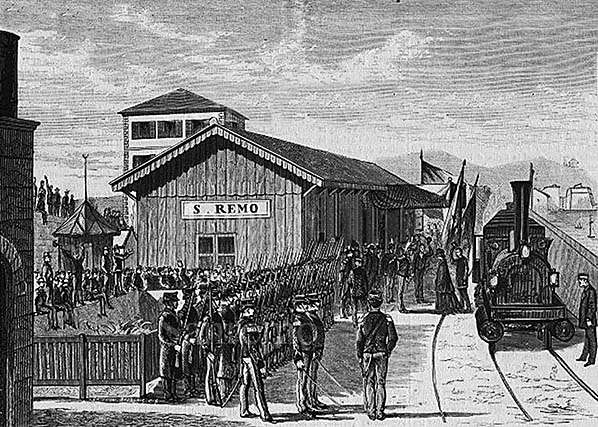 The earliest known illustration of Sanremo station dates from December 1874 less than three years after the station opened. Tsarina Maria Aleksandrovna arrives at Sanremo from Nice, where she is welcomed by Duke Amedeo of Savoy-Aosta, son of Vittorio Emanuele Il. The station building seen here is completely different than that seen in photographs taken around the turn of the 20th century so would be completely rebuilt within a few years. No platforms are seen here but that could be artistic licence. There appears to be a short canopy but this might be a temporary, provided for this occasion in the event of bad weather. A water tank and tower is seen on the far left. The station sign shows the original spelling, S.Remo or San Remo. It wasn't renamed San Remo until the 1980s. The building to the left of the station is not seen in any photographs. The locomotive has probably also been altered by the artist. It appears to have an open cab with spectacle plate. It does however resemble products supplied to Italy by Robertson Stephenson and Co. These were mostly 2-2-2 inside cylinder types but there were a small number of 2-4-0 outside cylinder types.
 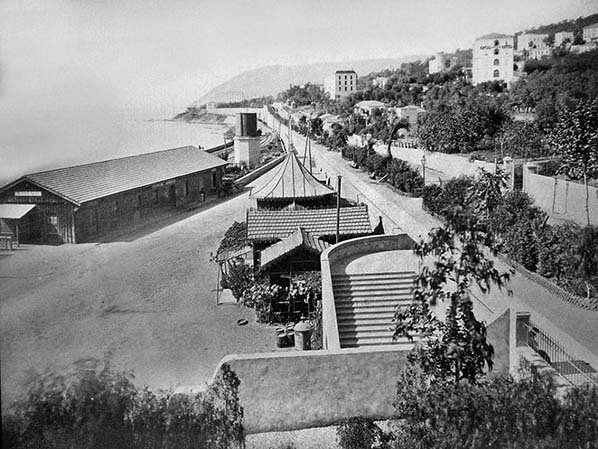
This c1880s view of the Sanremo station shows the original building with a water tank and tower at the south end of the building. Goods facilities are behind the photographer.
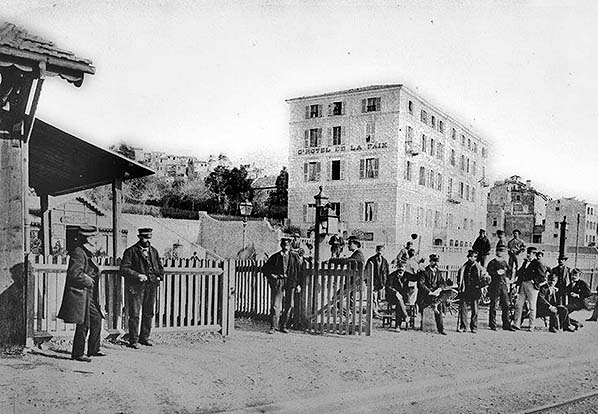
The north end of the original Sanremo station c1880s. It is assumed the staff are all railway staff most appear to be wearing a uniform. Freight traffic was handled at Sanremo and the yard was behind the fence. The goods shed is out of view to the right. The Grand Hotel De La Paix is seen in the background. From the middle of the 18th century the town grew rapidly, in part due to the development of tourism, which saw the first grand hotels built and the town extended along the coast.
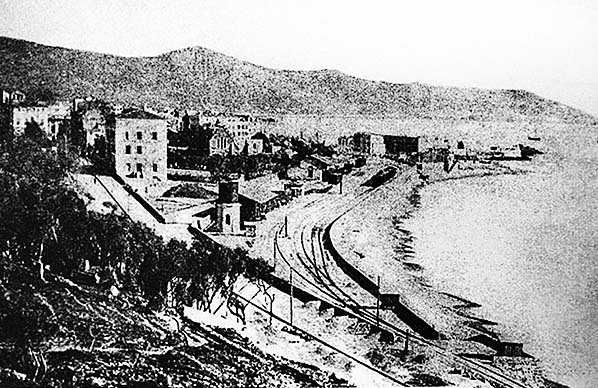
Looking north west towards Sanremo c1880s. The original station is seen in the centre with the water tower at the north end. The goods warehouse is seen beyond the station.
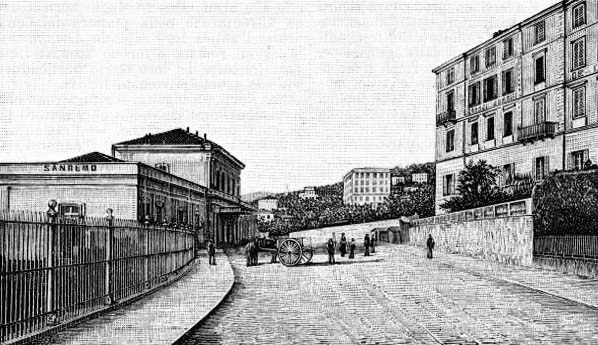
This woodcut was published in the illustrated monthly supplement of Il Secolo, Milan in 1889. perhaps to mark the opening of the new Sanremo station. Clearly a different building to the 1874 engraving above.
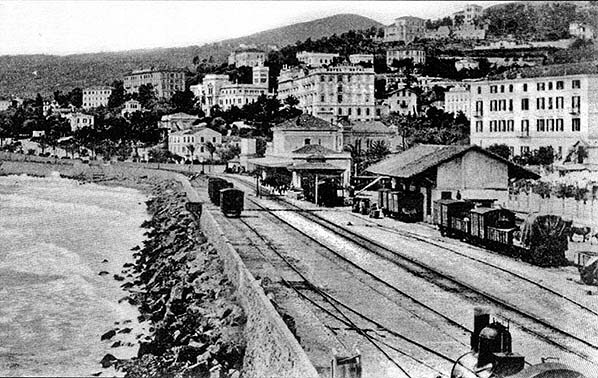
Looking south-west towards Sanremo station in the early years of the 20th century. Compared with the 1890 photo above , the station has been rebuilt with a central two storey section The water tank and tower to the south of the station is still there. A canopy stretches the full length of the station building and across one track. Platforms are not obvious but may be extremely low. A goods shed is seen on the right to the south of the station. The locomotive in the foreground appears to be a 600 Class; these were small 2-6-0 tender loco and were introduced in 1904 so that'll be the earliest possible date for this photo. It looks like the area had become more built-up between this photo and the 1890s photo.
Photo by Stefano Esposito from his Flickr Photostream 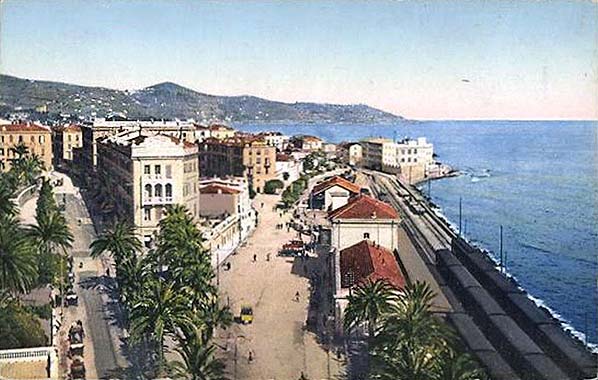 A postcard view looking north-east at Sanremo station in the early 20th century. The station is seen centre right with a long canopy stretching the full length of the station building. A goods shed is seen beyond the station.
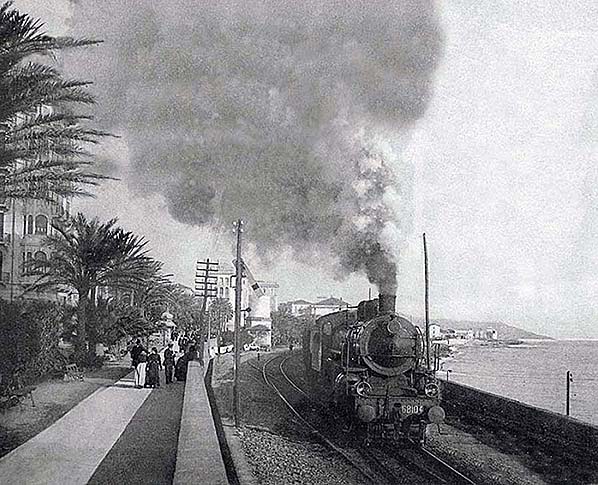
With San Remo station largely obscured by the train, what appears to be a goods train is seen heading in the direction of Ventimiglia and the French border. To the left of the train and just beyond the lower quadrant signal can be seen the points via which the track split into two of the three roads through the station. The points for the third track, on which the train is running, may be seen beneath the locomotive. Beyond the signal the water tower can be seen; the original station was much closer to the tank. The locomotive is 680 Class 2-6-2 four-cylinder compound No. 68109, built in 1910. She would in due course become No. 680.109. The class does not appear to have been particularly well regarded and many of the 151 strong class were eventually rebuilt, being given various class numbers along the way, to ultimately become the 685 Class. Of the few never rebuilt from original 680 Class form, all had been withdrawn by 1955. The railway through San Remo would be electrified on the AC three-phase overhead system (described briefly elsewhere) in 1931, thus we can only date this photograph to the 1910 - 1931 period and by looking at the clothing on show probably closer to the former.
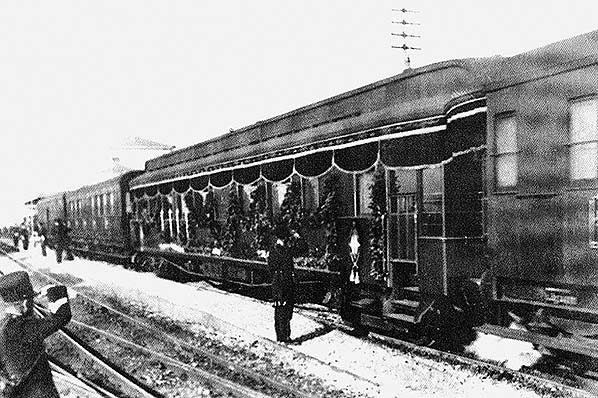
In January 1926 the train carrying the body of Italy's Queen Margherita from Bordighera to Rome passes through Sanremo station in a carriage decorated in mourning. No evidence of any platforms at the station at this date.
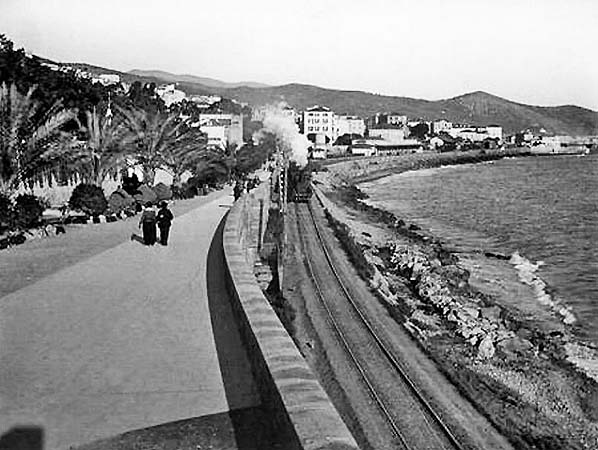
An unidentified steam service has left Sanremo station and is running along the single track Italian Riviera coastal line towards Ventimiglia c1930s.
Photo from Jim Lake collection 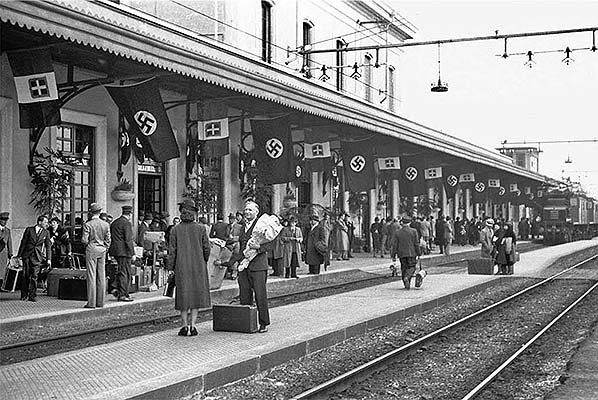
This is one of several photographs claiming to show the high-ranking Nazi Hermann Göring, his wife Emma (usually referred to as 'Emmy') and entourage arriving at San Remo for a holiday on 5 March 1939. The holiday was to last until 6 May 1939 although Hermann was absent for about one week, being called away for matters of State. Careful study of this photograph reveals the Görings are not present. The luggage on the main platform and general casualness of the people suggests the Görings had already arrived and left the station, the train in view on the right is, therefore, probably a normal service train which will pick up the people on the island platform. The general casualness of the scene contrasts somewhat with the banners which indicate some formality around the Görings arrival. The banner of the Third Reich is instantly recognisable; it had a black Swastika in a white circle set in a red background. The other banners are of Mussolini's Fascist Italy and the layout was green at the pole end - shield device on white - red. The shield device itself was a white cross on a red background with a blue border. In both cases there were variations to banners/flags of both Nazi Germany and Fascist Italy. While this Disused Stations website is not the place to elaborate on Hermann Göring it is nevertheless felt a very brief background should be given in order to provide a fuller picture. Click here to read it
Photo from Douglas Dewer collection 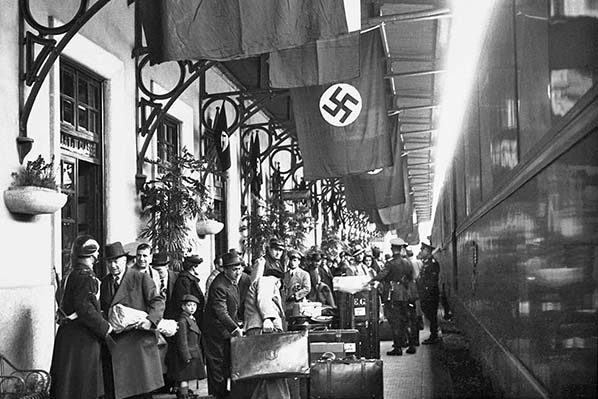 This is another of the numerous photographs taken of Hermann Göring and his wife Emmy at the time of their arrival at San Remo for a holiday on 5 March 1939. Again, neither Hermann or Emmy were present when this photograph was taken but quite why is unclear because there was no restriction on photography as far as is known and indeed plenty of photographs were taken of the Görings strolling around San Remo with their entourage. Hermann is believed to have arrived at San Remo wearing civilian clothing which included a dark leather overcoat. It will be noticed that a trunk on the platform bears the initials 'EG' and it is not unreasonable to assume the trunk belonged to Emma (Emmy) Göring, Hermann's second wife. Initials and logos are visible, just, on other items of luggage but none can be identified. The Görings stayed at, and no doubt indulged themselves at, the Hotel Royal. This hotel was to be damaged during the war and was subsequently rebuilt and its name reversed to the 'Royal Hotel'. It is still in business as of 2023. How the Görings reached San Remo, in terms of train used and where it originated, is something of a mystery. Security, the entourage, the copious quantity of luggage and Hermann Göring's elevated status, be that actual or self-perceived, would have meant a private or chartered through train. Göring did have a private train, 'Sonderzug Asien'. Unfortunately photographs of the event at San Remo station come only with very basic 'Göring arrives at San Remo' information and it is therefore easy to jump to conclusions, meaning the train depicted is not necessarily that upon which the Görings arrived even though it may be assumed to be. The private trains of the Nazi hierarchy bore the eagle-surmounting-Swastika device with the letters 'D R' positioned one each side of the Swastika (D R = Deutsche Reichsbahn) but surviving film of 'Asien' suggests not every carriage bore the device although modellers drawings contradict this. The device seen on the side of the carriage, which appears to be a luggage-utility vehicle, is too unclear but it appears to be mounted below a ventilation grille. Possible it is the eagle and Swastika device, possibly not. This is another of the numerous photographs taken of Hermann Göring and his wife Emmy at the time of their arrival at San Remo for a holiday on 5 March 1939. Again, neither Hermann or Emmy were present when this photograph was taken but quite why is unclear because there was no restriction on photography as far as is known and indeed plenty of photographs were taken of the Görings strolling around San Remo with their entourage. Hermann is believed to have arrived at San Remo wearing civilian clothing which included a dark leather overcoat. It will be noticed that a trunk on the platform bears the initials 'EG' and it is not unreasonable to assume the trunk belonged to Emma (Emmy) Göring, Hermann's second wife. Initials and logos are visible, just, on other items of luggage but none can be identified. The Görings stayed at, and no doubt indulged themselves at, the Hotel Royal. This hotel was to be damaged during the war and was subsequently rebuilt and its name reversed to the 'Royal Hotel'. It is still in business as of 2023. How the Görings reached San Remo, in terms of train used and where it originated, is something of a mystery. Security, the entourage, the copious quantity of luggage and Hermann Göring's elevated status, be that actual or self-perceived, would have meant a private or chartered through train. Göring did have a private train, 'Sonderzug Asien'. Unfortunately photographs of the event at San Remo station come only with very basic 'Göring arrives at San Remo' information and it is therefore easy to jump to conclusions, meaning the train depicted is not necessarily that upon which the Görings arrived even though it may be assumed to be. The private trains of the Nazi hierarchy bore the eagle-surmounting-Swastika device with the letters 'D R' positioned one each side of the Swastika (D R = Deutsche Reichsbahn) but surviving film of 'Asien' suggests not every carriage bore the device although modellers drawings contradict this. The device seen on the side of the carriage, which appears to be a luggage-utility vehicle, is too unclear but it appears to be mounted below a ventilation grille. Possible it is the eagle and Swastika device, possibly not.Photo from Douglas Dewer collection Click here for San Remo Station Gallery 2:
|
 The passenger building is preserved in good condition and the tobacco shop inside the building is still trading. A railway museum has been considered for the station building but at the time of writing the building is largely unused. Today the area hosts events and exhibitions in what were once the railway freight warehouses. At track level there is parking and a 30km cycleway though the station opened in 2008.
The passenger building is preserved in good condition and the tobacco shop inside the building is still trading. A railway museum has been considered for the station building but at the time of writing the building is largely unused. Today the area hosts events and exhibitions in what were once the railway freight warehouses. At track level there is parking and a 30km cycleway though the station opened in 2008. 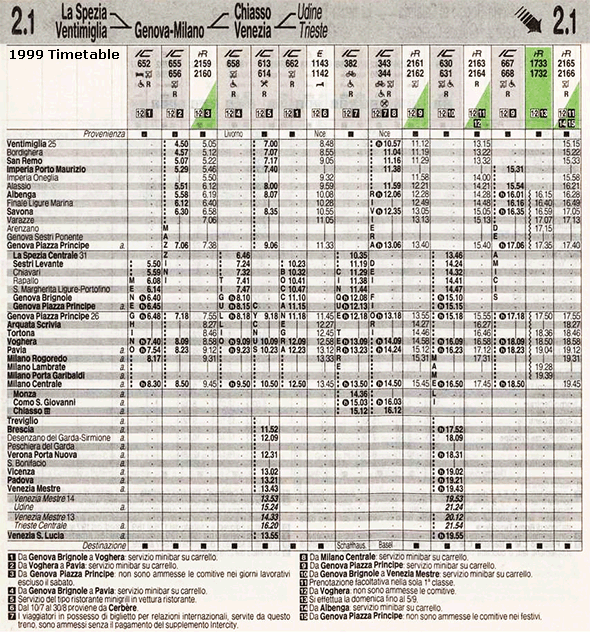
 In 1899, the year in which the official timetable of the Strade Ferrate, Tramvie, Navigation and Postal Services of the Kingdom of Italy was drawn up for the first time and included two Grands Expresses in service in Italy which were in transit through Italy: The Petersburg-Warsaw-Vienna-Cannes train was a luxury train, consisting only of sleeping cars and a restaurant car. It ran weekly between St Petersburg and Vienna and daily between Vienna and Cannes. It made the following stops in Liguria: Genoa, Alassio, Sanremo, Ospedaletti and Bordighera. The Nord-South Brenner express ran daily between Berlin, Munich and Milan and twice weekly between Milan, Genoa and Cannes. In Italy it stopped in Liguria at Genoa, Alassio, Sanremo, Ospedaletti and Bordighera. Other international trains, no longer 'Express', would follow to pass through the Ponente.
In 1899, the year in which the official timetable of the Strade Ferrate, Tramvie, Navigation and Postal Services of the Kingdom of Italy was drawn up for the first time and included two Grands Expresses in service in Italy which were in transit through Italy: The Petersburg-Warsaw-Vienna-Cannes train was a luxury train, consisting only of sleeping cars and a restaurant car. It ran weekly between St Petersburg and Vienna and daily between Vienna and Cannes. It made the following stops in Liguria: Genoa, Alassio, Sanremo, Ospedaletti and Bordighera. The Nord-South Brenner express ran daily between Berlin, Munich and Milan and twice weekly between Milan, Genoa and Cannes. In Italy it stopped in Liguria at Genoa, Alassio, Sanremo, Ospedaletti and Bordighera. Other international trains, no longer 'Express', would follow to pass through the Ponente.
 Home Page
Home Page